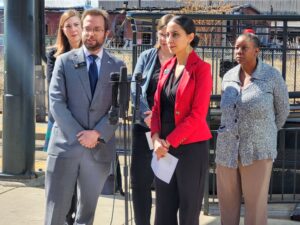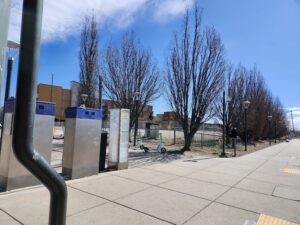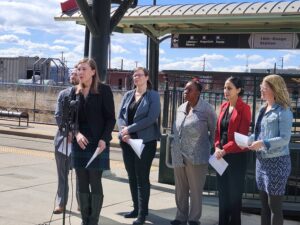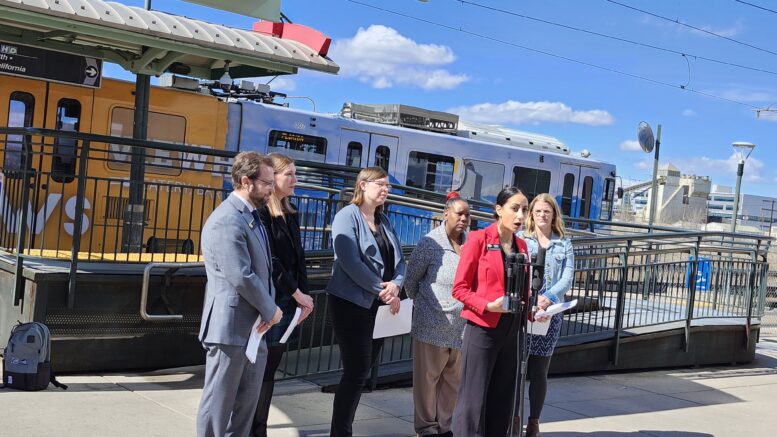Colorado legislators advanced the centerpiece bill in Gov. Jared Polis’ affordable-housing package Wednesday — a proposal that aims to increase multifamily-housing construction around transit corridors by requiring local governments to boost zoning density there.
House Bill 1313, which aims to create transit-oriented communities that can support lower-priced apartments and condominiums and let people live there without the expense of owning a car, is headed to the House Finance Committee on a party-line vote. It generated backing from environmental and housing advocates, as well as a handful of business organizations arguing the lack of housing has become an economic-development hurdle, but it faced significant pushback from local-government leaders.
That same pushback last year killed Senate Bill 23-213 — a far-reaching bill that sought to override local controls on development limits, allow single-family homeowners to build accessory dwelling units and fund housing-needs assessments on state and local levels. Polis and legislative advocates this year broke that bill into several pieces, but they did not lessen concerns of municipal officials saying the state grants local control over planning and zoning decisions and does not understand a community’s need like local leaders do.
A focus on transit corridors
Still, Rep. Steven Woodrow, the Denver legislator cosponsoring HB 1313 with fellow Democratic Rep. Iman Jodeh of Aurora, said that by creating more housing near workplaces or along transit lines that lead to job centers, legislators can change current dynamics. They can build more units in smaller spaces in a way that cuts costs, can reduce transportation greenhouse gas emissions by getting cars off the road and can make city centers now inaccessible to some workers into more dynamic mixed-income areas.

Colorado state reps. Steven Woodrow and Iman Jodeh speak at a news conference Wednesday about their housing bill.
“We all know that we suffer from an affordability crisis here in Colorado. We all know that we have to build more affordable housing,” Woodrow said during a news conference at a Regional Transportation District train station in Denver before the committee hearing. “People want to be able to live close to where they live. They want to be able to get their needs met close to where they live.”
Advocates on both sides of the political spectrum questioned, however, whether the provisions in HB 1313 would really create below-market-rate housing or incentivize people to use an RTD system struggling to win back riders after route cuts and safety concerns. And while municipal leaders said they too are working to boost needed affordable housing, they said the bill’s mandates to build and build more along passenger-rail routes and bus routes with high frequency forces cookie-cutter changes on communities.
“There’s actually a lot of alignment in the outcomes of the legislation to what municipal leaders want to do,” said Kevin Bommer, executive director of the Colorado Municipal League. “But the problem is this: This legislation starts with the presumption that local governments are the problem and must be told what to do by the state.”
How the bill works
HB 1313 establishes “transit-oriented communities” — local governments located within one of the state’s five metropolitan planning organizations with populations of at least 4,000 people that contain at least 75 acres within close proximity to passenger rail lines or high-frequency bus routes. That definition will cover 31 municipal or city governments, almost all of them along the Front Range, though other governments can opt in if wanted.

Transit-adjacent vacant lots like this one at 10th and Osage streets in Denver could be ideal sites for multifamily housing, supporters of HB 1313 argue.
These communities must increase housing density across their transit-adjacent areas to at least an average of 40 units per acre and submit plans on how to reach those goals through steps like allowing housing in commercial or industrial areas or permitting duplexes, triplexes and townhomes in areas zoned for single-family housing. They also must submit two short-term goals and one long-term goal to keep these areas affordable, choosing from ideas like implementing inclusionary zoning, expediting permitting for affordable housing development or creating fees on new development to fund below-market-rate housing.
Communities that do this can be eligible for grants to help them with their planning efforts, and the bill also creates a new tax credit for development of affordable housing. But those that fail to submit such Housing Opportunity Goals face the potential loss of Highway User Trust Funds that typically account for a substantial portion of local transportation and road-maintenance budgets.
Business support for transit-oriented communities
Several business groups — including the Denver Metro Chamber of Commerce, Colorado Concern and Boulder Chamber — backed HB 1313, with each saying that the affordability crisis is causing companies to think twice about relocating to or expanding in Colorado. Carly West, vice president of government affairs for the Denver chamber, noted that as Colorado has become the fifth-most-expensive state in the country for housing, queries on the availability of attainable housing have become the most common questions the Metro Denver Economic Development Corp. receives from prospective expanding employers.
“This has long-term impacts on our economic vitality and our ability to attract businesses to the state of Colorado.” West said at the pre-hearing news conference.

Carly West, Denver Metro Chamber of Commerce vice president of government affairs, speaks at a news conference for HB 1313 on Wednesday.
Several local-government leaders said that the proposal could have long-term effects on their ability to maintain transportation systems if the state does not deem them to have complied with the law. Centennial, for example, stands to lose $4 million a year and unincorporated Arapahoe County $9 million, elected leaders said — both more than 30% of those governments’ total annual road funding.
And this push to increase density along transit corridors may not lead to housing in those spots or to residents choosing to get out of cars and reduce the greenhouse gas emissions that bill supporters said are so important to cut through transit-oriented development.
Local government rebuttal
Greenwood Village City Attorney Tonya Haas Davidson noted her city, which could add 25,853 new units under the plan, has properties at light-rail stops that remain undeveloped because their owners are having financing problems rather than because of zoning limits. Also, residents and workers near transit stops choose not to use transit because of several different factors, she said.
“It’s very underutilized,” she said of an RTD transit system that she believes, if not improved, will force even transit-adjacent residents to use cars. “There are plenty of reasons for that, including safety and the fact that it doesn’t go where people want to go.”
Still, by a 7-3 vote, the bill heads next to the House Finance Committee, and it’s expected to get full support from the House in the coming weeks. Many other affordable-housing bills are scheduled to come up for debate in the coming weeks as well, making this an economic-development issue that will take center stage in the Legislature this month.
The 2023 proposal met its end in the Senate, where a number of key members have backgrounds in municipal government and may look askew still at the issue of pre-emption of local control. For now, however, the arguments surrounding the need for increased workforce housing and reduced greenhouse gas emissions that accompany HB 1313 are carrying the day.
